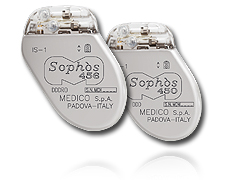 Sophòs 456 (DDDR)
Sophòs 456 (DDDR)




Sophòs 450 (DDD)



Sophòs 456 (DDDR) and Sophòs 450 (DDD) evaluate the cardiac mechanic activity on a beat-by-beat basis by measuring cyclic fluctuations of Trans-Valvular Impedance.
Furthermore, DR model (Sophòs 456) has an accelerometric sensor for rate modulation according to patient’s chronotropic needs.
Such characteristics, with a wide range of programmable parameters and functions, allow an effective optimization of therapy for each patient.
In addition to all functions available in other models of Sophòs family, Sophos 456 and 450 include new special functions and useful additional features, in particular :
- Auto-Setting TVI for an immediate activation of TVI-correlated functions.
- High Quality TVI waveform detection, memorization and measurement, for a long-term comparison of ventricular mechanical performance.
- Ejection check after ventricular pacing algorithm with energy trend of ventricular impulse variation.
- Ejection check after ventricular sensing, protection in case of oversensing.
- Ventricular pacing reduction with hemodynamic control thanks to TVI signal to further spontaneous atrial-ventricular conduction.
- Automatic implant and lead polarity recognition.
- Automatic lead polarity switch
- AF Prevention: Spontaneous atrial activity suppression.
- Automatic pacing threshold analysis by TVI signal with markers and TVI visualization.
Trans-Valvular Impedance TVI
TVI signal (Trans-Valvular Impedance) is measured between right atrium and right ventricle.
The possibility to choose the electrodic configuration to measure signal and the auto-calibration current system in order for such detection, allow to obtain an optimal signal in every implant, also in those cases of elective pacemaker substitution.
The sensor detects, cycle by cycle, the effective mechanical heart contraction, allowing to realize the functions of permanent ventricular ejection check with automatic adjustment of pacing energy in case of loss of capture (ejection check after ventricular pacing) and protection in case of oversensing with an automatic safety pacing in case of external interferences (ejection check after ventricular sensing).
Furthermore, it’s possible to obtain an hemodynamic monitoring of the patient, thanks to the long term storage capacity: in case of decay of hemodynamic performance an appropriate warning will be visible to the user on the programmer’s screen.
Diagnostic
Long-term monitoring of ventricular mechanics: TVI sensing provides the opportunity to monitor the mechanical performance of the hearth in acute conditions as well as in the long-term.
A wide diagnostic section, managed easily by programmer, allows to obtain all necessary information for an optimal pacemaker operation according to patient’s requirements.
![]() For more information or to get technical support on our products please CONTACT US >>
For more information or to get technical support on our products please CONTACT US >>
Products | Technology | Support | Contacts
